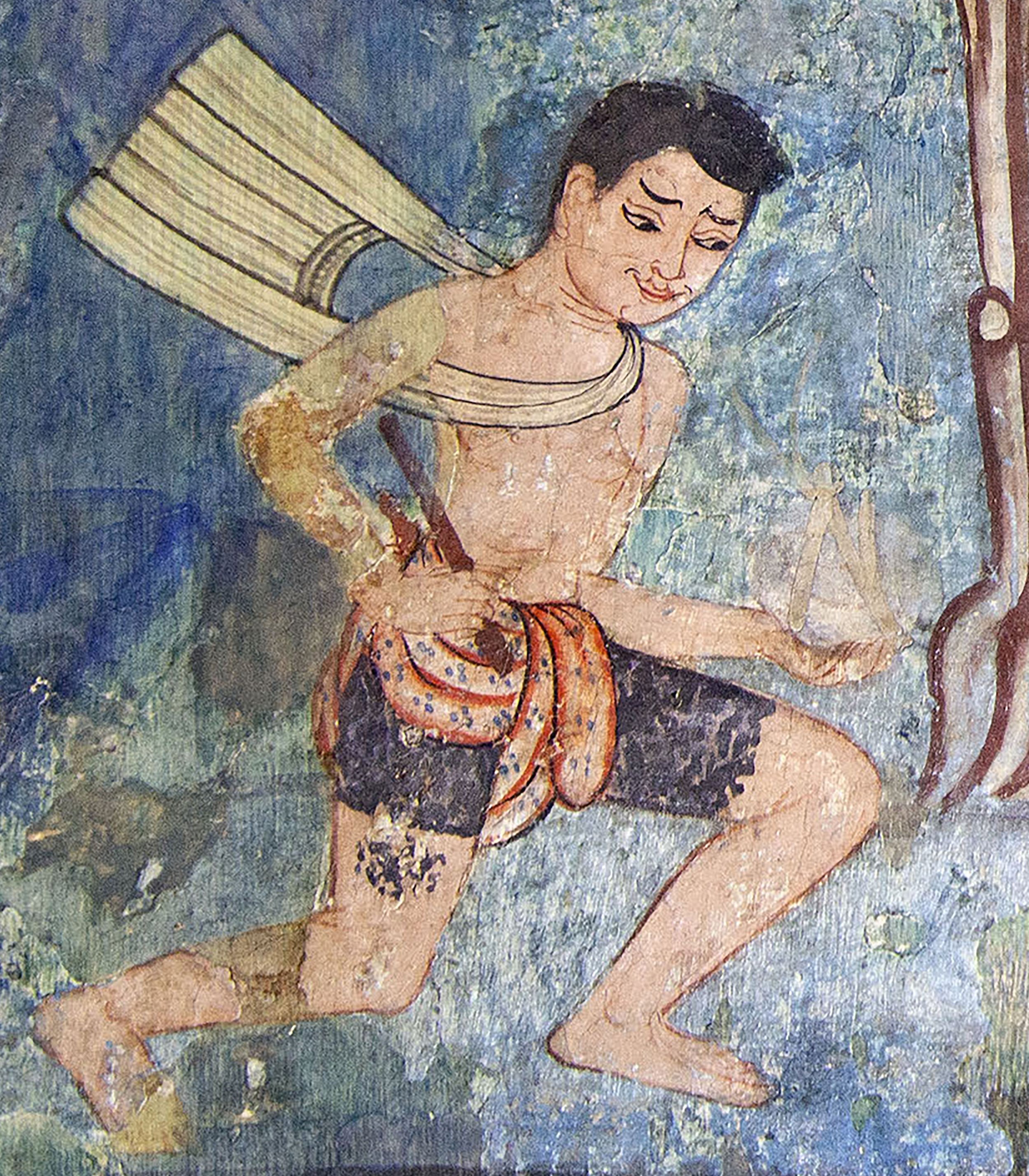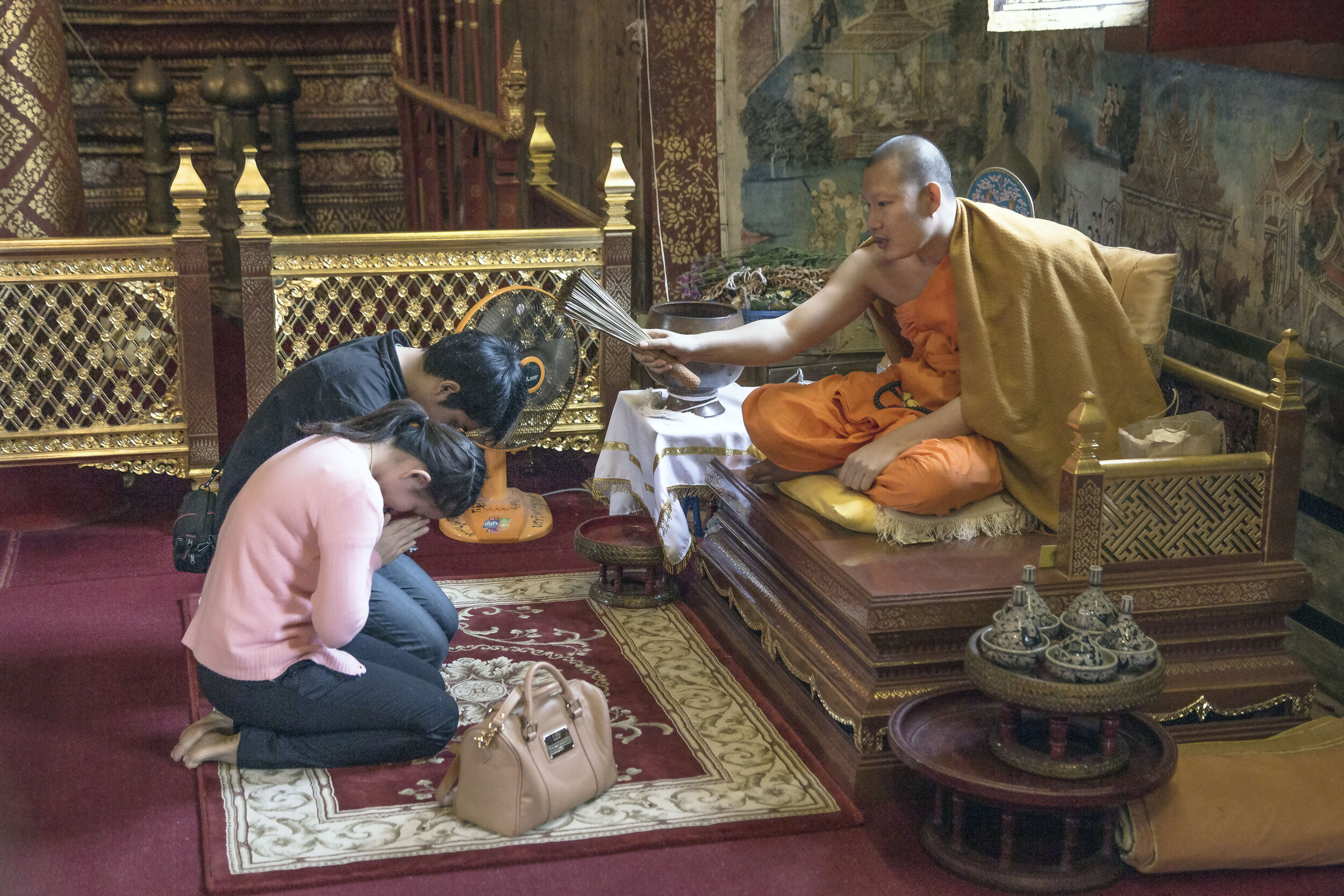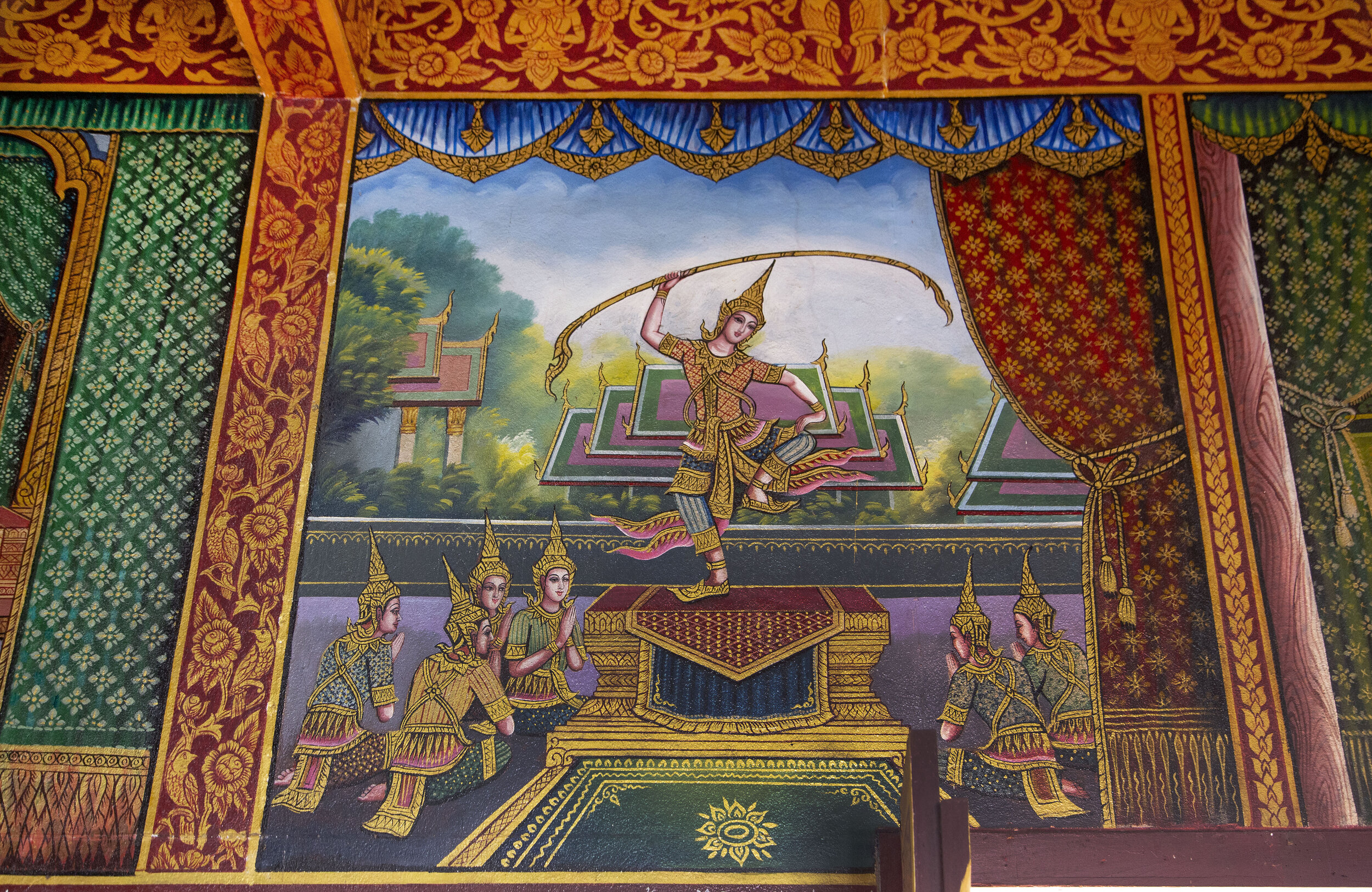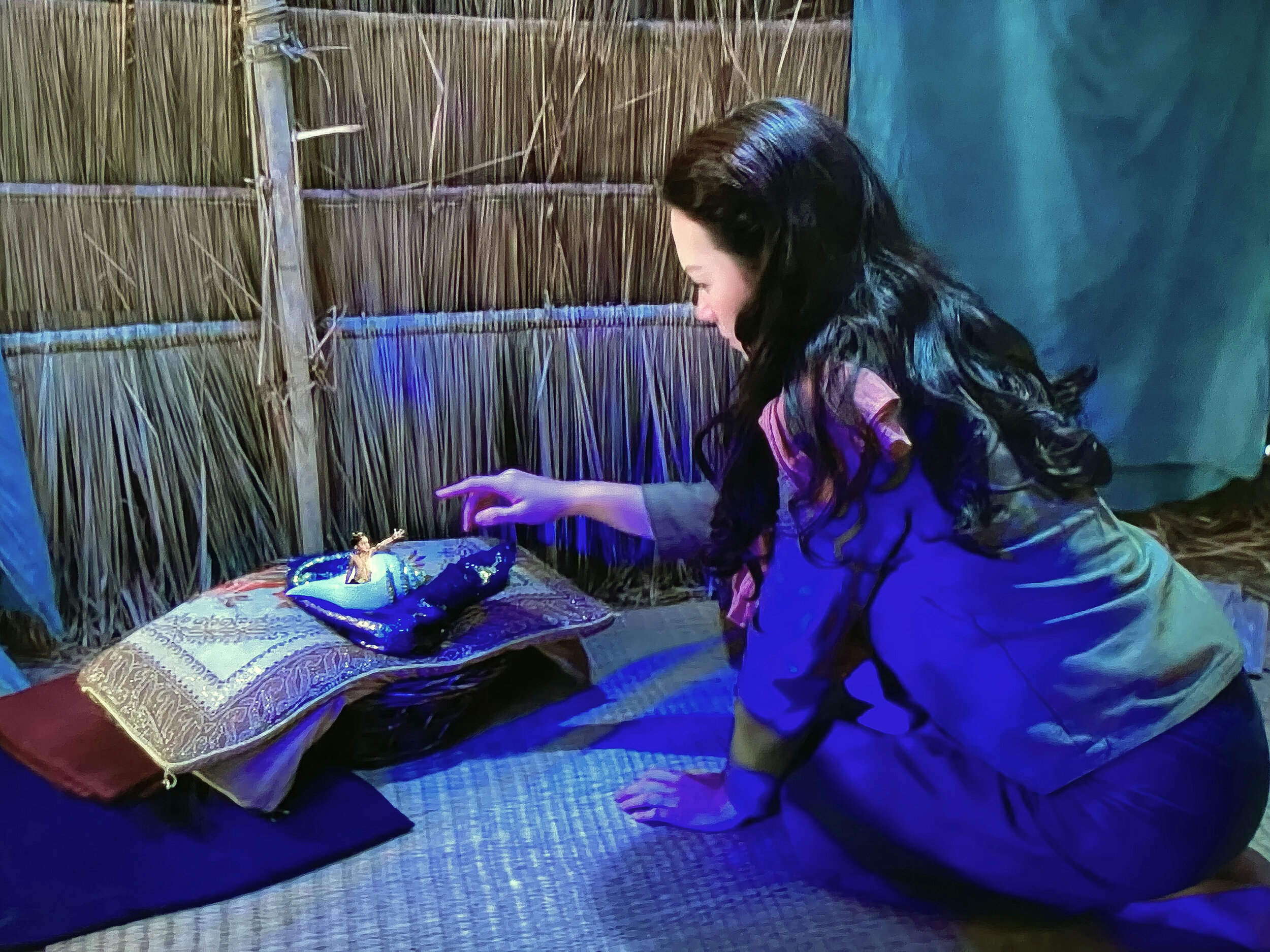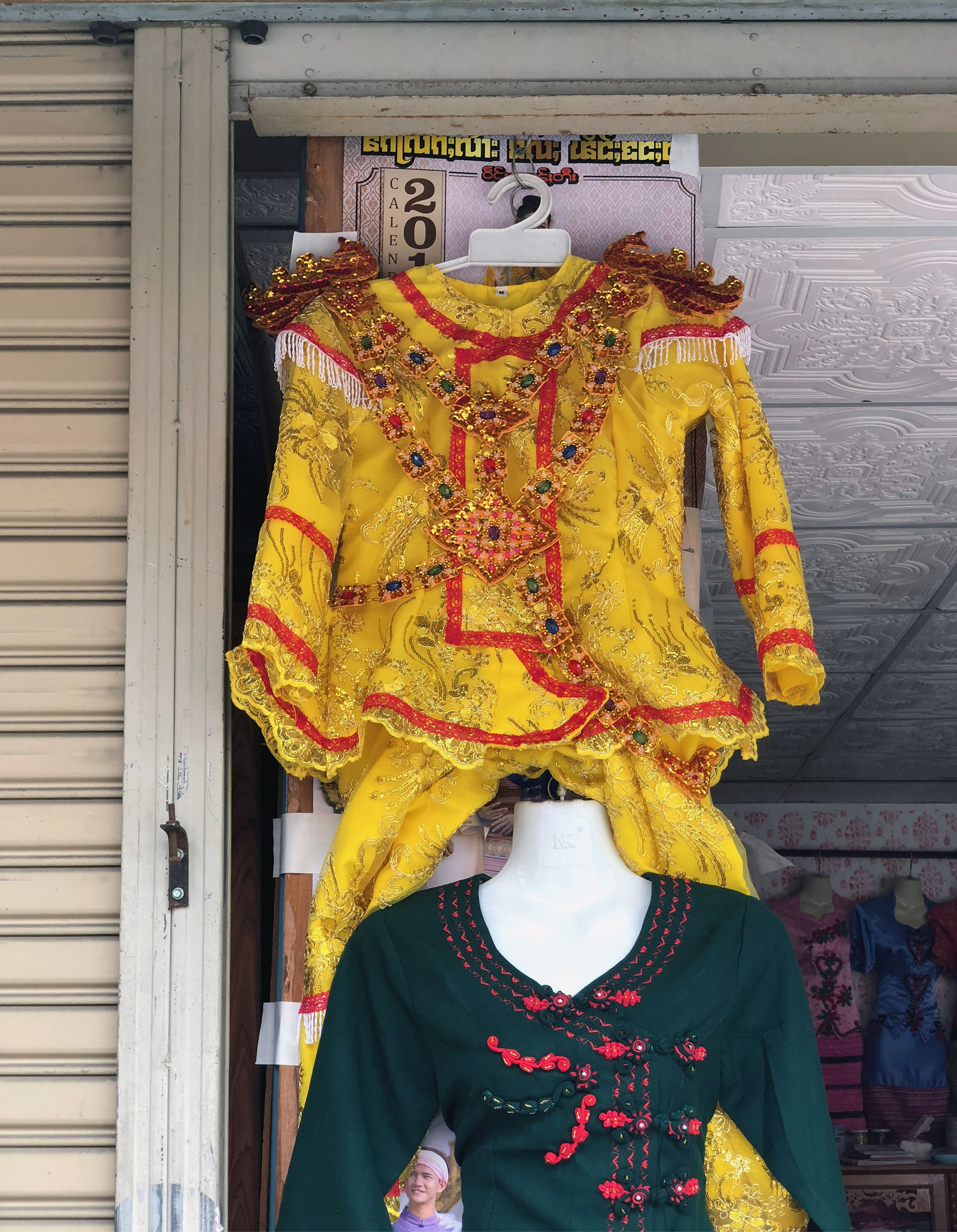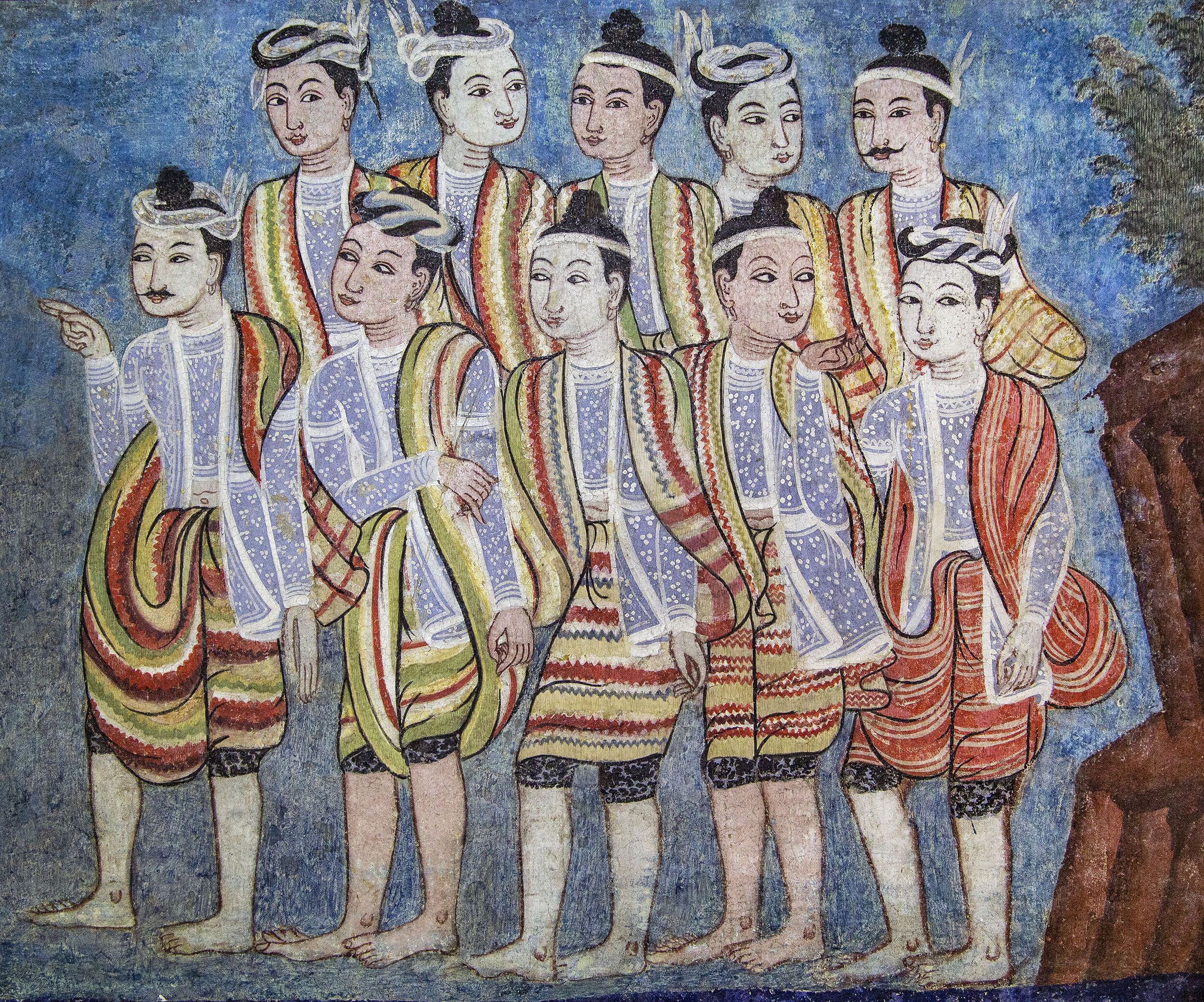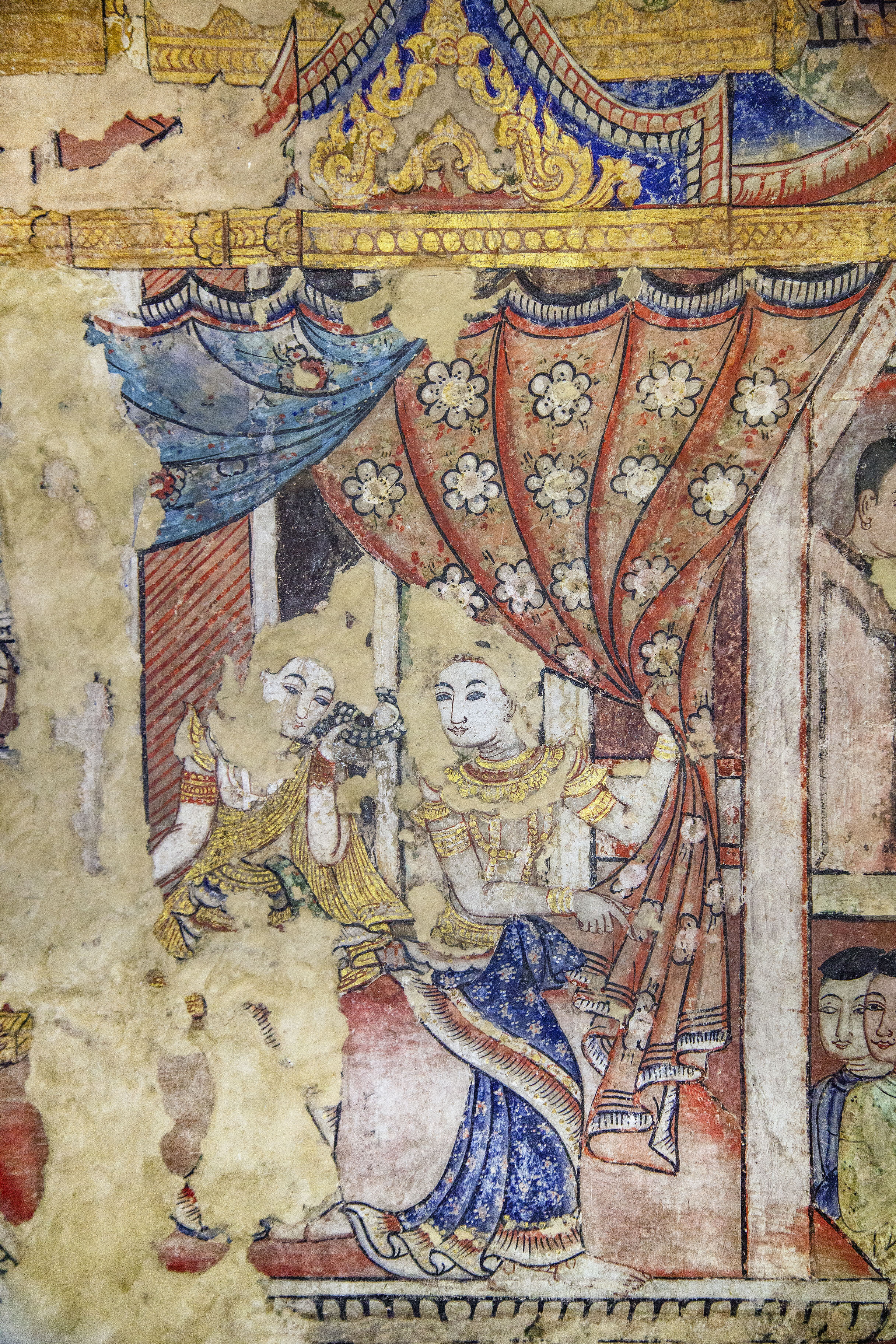Some story ellipsis is needed to wrap up the Sang Thong saga. A divine intervention, a war and destruction of the king’s capital is threatened, and all is resolved by a polo match. Stay tuned for the conclusion of the Apocryphal Bodhisattva.
Viharn Lai Kham and the Apocryphal Bodhisattva (26)
The sons-in-law are happy and relieved to accept Sang Thong’s requirement.
Detail of a future son-in-law rushing to provide Sang Thong with a piece of himself. Unaware of how it will backfire on him.
Viharn Lai Kham and the Apocryphal Bodhisattva (25)
The king sends Sang Thong and the future brothers-in-law with the separate tasks of finding wild game and fish. The brothers-in-law have no success with these quests, the consequences of failure are dire. In their desperation they turn to Sang Thong for help
With the Ngor mask and magical mantras he learned from his ogre mother, Sang Thong can easily summon all the animals and fish he and his companions will need. He is shrewd enough to require the other men to provide him with a piece of their ear and nose.
Viharn Lai Kham and the Apocryphal Bodhisattva (24)
Because Sang Thong’s appearance is that of a commoner, he must prove himself to be worthy of marriage to a princess. He will have to meet several challenges by the king.
Viharn Lai Kham and the Apocryphal Bodhisattva (23)
The Sang Thong murals cover most of the interior walls. Some of the murals are difficult to access given that the monks of the monastery perform their responsibilities seeing laypeople and performing blessings.
Blog on Break
Still contemplating my next post.
Viharn Lai Kham and the Apocryphal Bodhisattva - (Intermission) - Blog on Break
This photo-essay will continue in November.
Viharn Lai Kham and the Apocryphal Bodhisattva (22)
What is a Jataka?
On the night of his enlightenment, the Buddha, with his mind finally freed, saw the succession of his past lives: ‘When my concentrated mind was thus purified, bright, unblemished, rid of imperfection, malleable, wieldy, steady, I directed it to the knowledge of the recollection of past lives…This was the first true knowledge attained by me in the first watch of the night.’ We might not remember or even believe that there were, past lives in the technical sense it is used here. The metaphor is a useful one, however, to describe the potential hidden from us in our present human condition.
A Jataka is a story about a birth, and the collection of tales is about the repeated births—and deaths—of the Bodhisatta, the being destined to become the present Buddha in his final life. Written in Pail, the language of the Theravada Buddhist Canon, the tales comprise one of the largest and oldest collections of stories in the world.
The artistic creativity inspired by Jatakas in Thai temple art is an impressive testament to the central place these stories held in often non-literate Buddhist settings.*
*The Jatakas, Birth Stories of the Bodhisatta, by Sarah Shaw
Key scenes from the canonical past lives of the historical Buddha are formally used to decorate most temple interiors. They are framed with red and gold borders, sometimes with a theatrical curtain drawn to the side.
Occasionally, in less famous temples and viharn jatakas scenes are completely redone as opposed to restored.
We have already referred to the important contribution to religious writing made by local works such as the extra canonical Jatakas and especially that celebrated and fruitful series, the Pannasa Jatakas, which have themselves inspired many works in the Thai language.
Nirat
Along with with the folktales, Chak Chak Wong Wong, with their preoccupation with exiled princes using magic, Nirat are narratives of a journey, a poem of farewell characteristic of Thai literature. The genre is well defined; these are verses written in a personal mode., which is unusual; the poem is prompted by a separation, and the poet expresses his love and narrates the events of his journey. It was originally associated with the pilgrimages traditionally made in Thailand during periods when the rice-fields were not in need of constant cultivation.*
*Thai Painting by Jean Bosisselier
Viharn Lai Kham and the Apocryphal Bodhisattva (21)
Burmese marionettes: Minthta (the prince), and Minthamee (princess)
Formerly live actors were taught to be too impure to act the sacred Jataka stories down until the late nineteenth century. Puppets, being made of wood, however, “cannot act unwisely”, and hence held a monopoly on performance of jataka plays.*
*Theatre in South-East Asia by James R. Brandon
In Burmese puppet shows there are four categories of drama:
Yazawinzat: Historical dramas from the Yazawin chronicle, depicting the life of famous kings and heroes.
Hpaya tha maing: Religious stories and fables, especially pagoda tales.
Hto zat: Modern drama.
Jatakas and Mahavamsa: Birth-stories of the Buddha and stories from the chronicle of Sri Lanka.
The duet of the prince and princess (thit sa hta) is regarded as the highlight of every puppet show in Burma. The two are usually shown dancing in a forest, accompanied by two or four clowns, their attendants. The prince (min tha) and his new wife, a princess (min tha mi) are on their way home.*
Journal of the Siam Society Vol 82, Pt. 1 (1994), The Burmese Marionette Theater by Axel Bruns
Viharn Lai Kham and the Apocryphal Bodhisattva (20)
The story so far: images not represented on the Sang Thong mural.
These images are screen shots from the epic 20 plus hour series on Thai television.
Banished from the kingdom, and living with an old couple Sang Thong’s mother discovers the secret of the conch shell. Soon after she will break the conch shell and she and her son will end up on a raft adrift in the ocean. They are separated and Sang Thong is rescued by a Naga King. Nagas are mythical beings that live underwater and can transform from human appearance to a snake.
Like a cross between Captain Nemo and the monstrous giant squid in Jules Verne’s 20,000 Leagues Under the sea the Naga King lives secure beneath the ocean. He will be the first of many foster-parents for Sang Thong.
Back at the court of Sang Thong’s father the king, the sorceress serving king’s jealous second wife uses her occult powers to seek out Sang Thong and his mother to destroy them.
The Naga King looking for a more suitable mother for Sang Thong offers him to a childless orgress. She hides her true identity from Sang Thong by magically transforming her appearance and that of her court to look like normal humans. She cannot help being true to her nature and roams the forests looking for humans to eat.
Deva ex Machina: Whenever Sang Thong gets into real trouble, Indra, king of the gods, sends an angel to make things right.
Viharn Lai Kham and the Apocryphal Bodhisattva (19)
The Suvannahong (Suvannahamsa Jataka) is illustrated on the opposite wall from the Sang Thong story. This time the Bodhisattva is Brahamdatta, son of the King of Benares. He has many adventures as he traverses the whole of the Jambudvipa with the aid of a flying machine resembling a golden hamsa (a kind of mythical wild goose), hence the name of the Jataka.*
*Thai Painting by Jean Boisselier
Image from Viharn Lai Kham’s wall opposite the Sang Thong saga. A prince and his rescued princess do battle with an army of ogres in the forest.
The Shinbyu Ceremony
The Shan people of northern Thailand have a ceremony that marks the initiation of young boys into adults. It is also known as the Crystal Sons ceremony. Every Burmese Buddhist boy has to enter the Buddhist order of monks before he grows to manhood. As a part of the ceremony alms are offered to the monks, and friends are invited to the reception given by the parents of the boy. The boy is mounted on a horse or rides on the back of his father.
Why is the boy dressed as a prince or king?
The usual answer is that the boy is following the path of purity followed by Prince Siddhartha, who forsook his luxurious life of a prince to become a recluse and later the Buddha. The boys is, in effect, enacting the scene of Prince Siddhartha’s renunciation of the world. But this explanation is merely an afterthought meant to give a Buddhistic basis to a pre-Buddhistic ceremony.
Store front selling a costume of a prince for the Shinbyu ceremony in Chiang Mai.
The word Shin means ‘monk’, but it can also mean ‘lord’ or ‘king’. The phrase Shinbyu means ‘to make a monk”, but it can also mean "‘to make a king’. The boy who is going to be initiated is called a Shin-luang, which means ‘he who would be a monk’, but it can also mean ‘ he who would be a king’.
In Thailand this ceremony is called Poy Sang Long or “Crystal Sons”.
In Burmese society, although the king and his officials were at the top of the social structure, everyone could hope to be king one day, and as the king’s officers constituted a nobility by talent and not by birth, even the humblest peasant, if he had the ability, could hope to become an official of the highest rank. Burmese folk-lore is full of stories of poor boys becoming kings, and chronicles mention many instances of persons ‘not of royal bone’ becoming kings.*
*Folk Elements in Burmese Buddhism>Initiation Ceremonies by Muang Htin Aung
Viharn Lai Kham and the Apocryphal Bodhisattva (18)
Not all temples in southeast Asia hide their paintings inside. In Laos, many temple facades are illustrated with Jatakas (birth stories of the Buddha) or scenes of the path to enlightenment of Gotama, the Buddha of the current age. The facade of Wat Ho Xieng in in Luang Prabang provides numbers to each scene and a lectern with textual descriptions. The guardians on the doors are balletic figures of forest rishis.
Click on image to enlarge
Interior of viharn in Luang Prabang, Laos
Viharn Lai Kham and the Apocryphal Bodhisattva (17)
Another version of The Great Departure reflecting stylistic elements of Shan culture.
Many Shan princes can trace their ancestry to before the twelfth century, although local myths and legends give a much earlier history that links them to heavenly beings in the Buddhist Tavatimsa Heaven. According to Buddhist cosmology, a prince was a bodhisattva (a being on the way to Enlightenment) who resided in a royal palace built as a symbol of a celestial mountain. He should have a tiered and canopied throne and a tiered crown, symbols of cosmological and protective forces.*
*The Shan, Culture, Art and Crafts by Susan Conway, River Books
Detail of mural in Wat Buak Khrok Luang, Chiang Mai, Thailand
Click on image to enlarge
The image above is a composite of Shan architecture, Prince Siddhartha is dressed as a Thai prince wearing a “Crown of Victory” and his wife sleeps bare-breasted in a wrap-around skirt typical of woman of La Na.
Viharn Lai Kham and the Apocryphal Bodhisattva (16)
Burmese tribute dress worn by a Shan prince. The Shan princes who paid tribute to Burma were allocated court dress and regalia. Sang Thong and many of the royal courtiers in the murals in Viharn Lai Kham wear this type of dress. It is distinct to Shan States that today are part of Myanmar, not Siam or Lan Na.
The Shan chronicles recount stories of heavenly beings descending to earth from the Buddhist Tavatimsa Heaven. The Shan people regarded their coming as auspicious and asked them to stay on earth. The heavenly beings agreed and were taken in golden chariots to palaces where they donned supernatural clothing and regalia and conducted state affairs while seated on gem-studded thrones.
The concept of a ruler whose ancestors came from heaven was interpreted in Shan court dress and regalia. The sight of a prince with the rays of the sun reflecting off his golden robes or a princess with the tropical light shimmering off her dress lured foreign visitors to speculate on the supernatural.
Picture and text credit: The Shan, Culture, Art and Crafts by Susan Conway
Sang Thong wearing his mask and Burmese Court inspired clothing.
Is this a picture of a dancer dressed as a prince or a prince dressed as a dancer?
With the advent of photography many royals in Shan and Burmese society posed for pictures dressed as dancers wearing the flamboyant appendages of the court and courtiers.
Wat Buak Khrok Luang, Chiang Mai, Thailand
A scene from the life of the Buddha, from Myanmar (Burma). The Great Departure: Siddhartha, who will be the Buddha, arrives dressed in the royal regalia of the Shan bids farewell to his wife and child. In Southeast Asia it is common practice to transpose the cultural attributes of Prince Siddhartha into that of the host country.
Image from temple on Inle Lake in Myanmar
Viharn Lai Kham and the Apocryphal Bodhisattva (15)
Some of the supreme pleasures of the Sang Thong mural are the opportunities taken by the mural artist to portray regional people in their native clothing. Here are Shan and Burmese officials detailed down to their leg tattoos reaching down just below their knees.
The author admits to some slight Photoshop magic used to create a clean border on the left.
Tender, intimate scenes of lovers flirting enliven the Sang Thong story.
There is a tremendous sensitivity to the fabric design on these two women, one with a golden fan and the other selling her wares from a pannier slung over her shoulder.
Viharn Lai Kham and the Apocryphal Bodhisattva (14)
The king was upset with the choosy behavior of his daughter, so he sarcastically asked if all the men in the city had come to be chosen. Then he was informed that there was one more ugly man living outside the city. To ridicule his daughter, he called Sang Thong (who was now known among the people as Ngor) to the palace to be selected or rejected.
Sang Thong mocked at court.
Beyond the King’s expectation, the youngest princess suddenly developed a liking for Ngor. Since they were born to be husband and wife, she saw Ngor as a handsome man with a golden body and fell in love with him. The reason this happens is explained in the text: Because Sang Thong and Princess Rochana knew each other in their past lives and had made great merit together.
The hand of Kamma (karma) in Southeast Asia folklore
Invisible to western readers are the machinations of kamma determining interpersonal relationships and more superficial attributes like a beautiful face, wealth and power. Broadly speaking, in folklore narrative, asian readers and hearers will automatically know that good-looks and prestige come from the merit one has accumulated from living virtuous past lives.
Viharn Lai Kham and the Apocryphal Bodhisattva (13)
The King seeks out a husband that will punish his fussy daughter. Sang Thong wearing his “ugly” disguise has found work as a cowherd, a lowly common job far from the example of a handsome prince. (Sang Thong’s image here has suffered from peeling paint damage).
Viharn Lai Kham and the Apocryphal Bodhisattva (12)
Some of the princes and princesses in Thai folktales are born in unusual circumstances, for instance in a shell, in a tree, in a drum, etc.
Finding a mentor
An orphan or exiled prince must risk his life to acquire a magic weapon. Hermits and mythical beings like ogres in the forest become the typical mentors for a wondering prince. Every prince in Thai literature and Chakchak Wongwong fables receives a magic weapon at birth or from a hermit or ogre (giant) who is his mentor or foster parent. An example is a giant who sends a prince to collect some saphaya, which are magic leaves.
The Saphaya Tree
is a story about a giant who brought up a boy as his very own son. One day when he goes to find some food the boy wanders into a cave where he finds a saphaya tree whose leaves come in different colors: red for becoming a naga; white, for becoming a monkey; green, for becoming a bird; and yellow, for turning the skin into gold.
In another version:
After the boy gives the leaves to a hermit, he receives a magic blanket as a reward. If the prince covers himself with the golden side of the blanket, his skin will turn gold like that of a deva (god). If he covers himself with the gray side, he will turn into an ordinary fellow.*
The Saphaya Tree tales has striking parallels with the Sang Thong tale that make the odd detail: the single blanket that does double duty providing both the golden skin and that disguises the true appearance of the protagonist, like San Thong’s Ngor mask.
*The Legacy of Traditional Thai Literature and Its Impact on Contemporary Children’s Literature by Ruenruthai Sujjaunpun
A Lanna Tai woman admires the tree blossoms in her garden. Trees are prized for their beauty, their fruits and as magic objects. Trees can be homes to ghosts and benevolent tree spirts that can fulfill wishes.
Sidhisara Jataka
In this tale tree spirits recognize the merit of the main character and they advise him how to find various magical articles.
Narajiva’s Kathina Jataka
A deformed man in the Himavanta forest receives two branches from a magic tree. By eating one, he loses his deformity and becomes handsome. He tricks his enemies into eating the other branch, which turns them into monkeys.
Viharn Lai Kham and the Apocryphal Bodhisattva (11)
Jao Ngo Mask
The mask of Jao Ngo Phan is used by Sang Thong as a magical protector and tool for success.
Sang Thong receives magical armor which has a Jao Ngo Mask. When he places the mask on, he converts and transforms his appearance into a Jao Ngo Pha who appears to be a raving lunatic with black wooly hair, The special ability of the Jao Ngo is that he can survive and not starve in the deep jungle.
This mask also comes as an amulet with occult powers. The Jao Ngo is able to call meat and fish to come to him without going out to look for it.*
*thailandamulet.net
Sang Thong performed as a dance drama.
Viharn Lai Kham and the Apocryphal Bodhisattva (10)
King Samon finds husbands for all his daughters but one. Princess Rochana rejects all the men before her.
The furious king did not know what to do with his stubborn daughter, so he ordered another round of candidates and invited the men indiscriminately, saying “Send out drummers to announce that tomorrow Princess Rochana will throw a garland to find a husband by chance.” *
The next morning all the city folk including courtiers dressed up and went to the gathering at the royal courtyard. The king sent for his daughter and said, “Beloved daughter, you must throw the garland up in the air. Any man who has made merit with you in the past, let the garland land around his hand, and I will marry you to him.”
Detail of Princess Rochana with the flower garland she will bestow on her future husband



